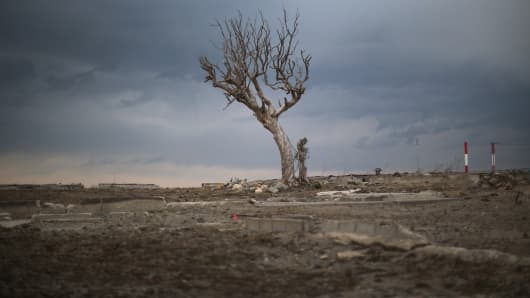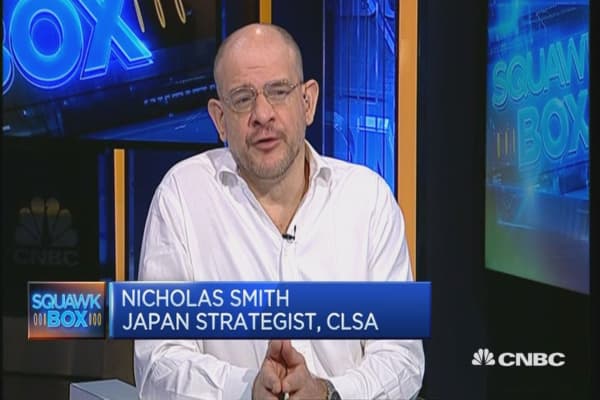http://www.cnbc.com/2016/03/10/us-watches-as-fukushima-continues-to-leak-radiation.html

U.S. watches as Fukushima continues to leak radiation
CNBC.com
Five years after an accident at the Fukushima nuclear plant in Japan, some scientists continue to find found small amounts of radioactive material along the West Coast of North America. And some of them say we should expect to see this in the ocean for decades to come. Elevated levels found off the coast of Japan show that the situation is not yet under control, and that the facility is still leaking radiation.
But the levels observed near the United States are below — very far below — those set by health and safety standards, and are also far outstripped by naturally occurring radiation.

On March 12, 2011, an earthquake triggered a tsunami that struck 700 miles of coastline and caused a disaster at the Fukushima nuclear plant. It was considered the worst such disaster since the meltdown at the Chernobyl nuclear plant in Russia in 1986.
Much of the radiation from the disaster leaked into the sea, leading to fears in other countries that the toxins would poison marine ecosystems and fisheries, and cause cancer or other health problems for humans.
U.S. scientists began receiving phone calls from concerned citizens asking them if it was safe to eat fish or swim in the ocean.
While government agencies looked for radiation in soil, air, drinking water and the food supply, oceanographer Ken Buesseler said a “traditional gap” in government agency responsibility leaves ocean radiation unstudied.
But the public was concerned — Buesseler was getting phone calls from worried citizens. There had also been a series of massive die-offs of marine life, especially sea lions, and some of the people Buesseler talked to feared the die-offs resulted from radiation, he said.
He and a team secured a grant from the Moore Foundation and ran a crowdfunding campaign to pay for a vessel, researchers, and the equipment needed to take seawater samples near Japan and North America.
His team looked for a particular radioactive isotope called cesium-134. That isotope is particularly useful because it has a very short, two-year half-life. If there was cesium-134 somewhere in the ocean, it almost certainly would have to come from Fukushima. Other isotopes — such as cesium-137 — have far longer half-lives. There still is some cesium-137 in the ocean from nuclear tests conducted in the middle of the 20th Century, for example.
Cesium is soluble in seawater, so it is easily taken up and dispersed by ocean currents. This may partly be a good thing: The ocean is vast, and it has quickly diluted concentrations in the most affected area around Japan.
But it does mean radiation can spread out across the Pacific and around the planet.
Last December, Buesseler and his team said they had found a spike of cesium-134 off the coast of California — about 11 becquerels per cubic meter of water. Becquerels are a unit measuring radiation. Buesseler and his team reported finding about 10 becquerels per cubic meter of water 1,500 miles north of Hawaii. That was a level around twice as high as levels they had found on previous missions.
Five years later, scientists have reason to assume radiation from the Fukushima disaster is still showing up on U.S. shores. And they will likely continue to leak and drift for decades to come.
Then again, these levels are extremely small. To put 11 becquerels in perspective, a single dental X-ray would expose a person to 1,000 times more radiation than swimming in that water for an entire year, according to Buesseler. It is about 500 times lower than the U.S. government standard for safe drinking water.
Manley, who studies kelp and seaweed, was also receiving phone calls from people worried about radiation in the ocean shortly after the accident. He contacted Kai Vetter, a researcher and professor at the University of California, Berkeley, who had already started a project monitoring the air for radiation after the accident.
They formed a group called Kelp Watch in the wake of the accident. The group involved 52 marine scientists taking kelp samples at sites ranging from Kodiak Island off the coast of Alaska, to Baja California, in Mexico, and as far east as Hawaii. To date, they have found no detectable levels of radioactive isotopes in kelp or seaweed tissue. Vetter told CNBC that they are certain there is some radiation from Fukushima in the kelp, but the levels are so low their equipment has not been able to detect it.
The radiation Buesseler was measuring in the Pacific was orders of magnitude smaller than what would be required to cause the aforementioned sea life die-offs in the Pacific.
Separate research from NOAA and other groups has tentatively connected some of these deaths to toxins released by plankton blooms — products likely of unusually warm ocean water common during El Nino. In any event, Buesseler said, if the levels were high enough to lead to die-offs around the Pacific, there would have to be greater marine life losses close to Japan, and there haven’t been.
Radioactivity is everywhere, and most of it is naturally occurring.
“We are living in a radioactive world, and we are exposed to it all the time,” Vetter told CNBC.
And to a certain extent, humans can handle it. However, radiation can be carcinogenic — sun exposure can cause skin cancer, for example. But small amounts of sun exposure are not necessarily harmful, and the body has repair mechanisms to handle damage. It is also important to keep radiation from specific sources in perspective.

A study commissioned by Congress in 1999 estimated that the air in the U.S. averages about 15 becquerels of radon per cubic meter. Kelp has naturally occurring potassium-40, another radioactive isotope and “the potassium-40 levels in kelp are extremely high compared to the very small amount of cesium that has been detected in seawater,” Manley said.
That said, it is still necessary to keep a close watch over radioactivity levels from the accident.
“We are not completely out of the woods,” Buesseler said. The Fukushima site is still full of radioactive material, and there have been some leaks since the accident that have released more material into the environment.
He said there about a thousand tanks full of “something on the order of 750 million tons of water that are far more radioactive than anything in the ocean.” There is also radioactive material in the groundwater, soil and in the buildings.
“I expect to see small leaks for decades to come,” he said. “It is a difficult thing to have soil and groundwater and buildings contaminated to this extent and not have that leaking out.”
The public concern in some quarters is still high.
Vetter was motivated to start RadWatch — the air-monitoring project — and Kelp Watch with Manley “because we felt, and it was confirmed by the public, that the government was not doing enough in that communication, they were not really measuring, to a large degree and the message was, ‘Don’t worry about it.’ But people were worried about it, and justifiably so.”
All three scientists told CNBC that some members of the public — albeit a small minority — have done everything from questioning their findings to, in some cases, threatening them.
“Whatever you claim, whatever opinion you have, you can find confirmation on the Worldwide Web,” Vetter said. “Which is great, but also a great risk.”
Manley said that “as soon as we started putting our data up on Kelp Watch people began contacting us to complain. They said, ‘Oh you are lying, or you are telling half-truths. You can’t really have a conversation with them because they attack your credibility, rather than your data. It was a real eye-opener for me.”







